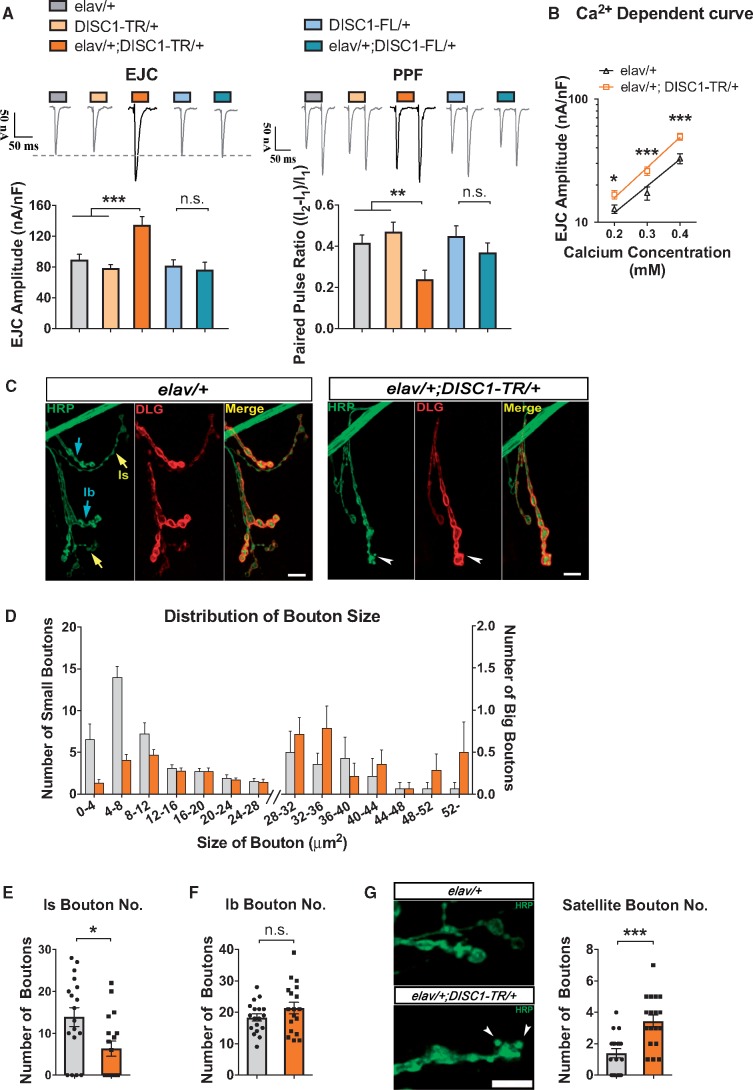Figure 2.
Expression of schizophrenia-related form of DISC1 (DISC1-TR) leads to aberrant glutamatergic transmission, plasticity and morphology of Drosophila larval neuromuscular junction (NMJ). Representative EJC traces and group data showed that pan-neuronal expression of DISC1-TR (elav-Gal4/+; DISC1-TR/+) but not DISC1-FL (elav-Gal4/+; DISC1-FL/+) led to increased EJC amplitude and reduced PPF ratio. The extracellular calcium concentration for recording was 0.4 mM. (ANOVA, n = 10; in DISC1-TR expressing group, P < 0.0001 for EJC, P = 0.0065 for PPF; in DISC1-FL expressing group, P = 0.5072 for EJC, P = 0.7231 for PPF). Calcium-dependent curve of EJC. Pan-neuronal expression of DISC1-TR (elav-Gal4/+; DISC1-TR/+) led to augemented EJC amplitude at 0.2, 0.3, and 0.4 mM calcium concentrations. (t-test, n = 23 and 18 for 0.2 mM; n = 10 and 12 for 0.3 mM, n = 17 and 14 for 0.4 mM, P < 0.05 for 0.2mM Ca2+; P < 0.001 for 0.3mM and 0.4mM Ca2+). The morphology of NMJ boutons in the control animals (elav-Gal4/+, left panel) and DISC1-TR larvae (elav-Gal4/+; DISC1-TR/+, right panel). Drosophila NMJs were co-immunostained with antibodies against horseradish peroxidase (HRP) (green; labeling presynaptic motor neuron membrane) and discs large (DLG) (red; labeling postsynaptic musicular membrane). Satellite boutons are indicated by white arrowheads, the type I big (Ib) boutons, the type I small (Is) boutons, and satellite boutons are indicated by blue arrow, yellow arrow, and white arrowhead respectively. Boutons from muscle 4 of the 3rd or 4th segments of larvea were statistically analyzed. The distribution of bouton size in control (elav-Gal4/+) and DISC1-TR expressing larvae (elav-Gal4/+; DISC1-TR/+). Epression of DISC1-TR led to a reduced number of small boutons (left to the double slash), and an augmented number of large boutons (right to the double slash). The number of Is boutons was decreased by the expression of DISC1-TR (elav-Gal4/+; DISC1-TR/+). (t-test, n = 14, P = 0.0128). The number of Ib buotons of DISC1-TR expressing larvae (elav-Gal4/+; DISC1-TR/+) was the same as that of the control group (elav-Gal4/+). (t-test, n = 18, P = 0.1803). The number of satellite boutons was dramatically increased in larvae expressing DISC1-TR (elav/+; DISC1-TR/+) (t-test, n = 18, P = 0.0002). White arrowheads in the left panel of 2C indicate satellite boutons. Scale bars are 5 μm. All data are represented as mean ± SEM.

